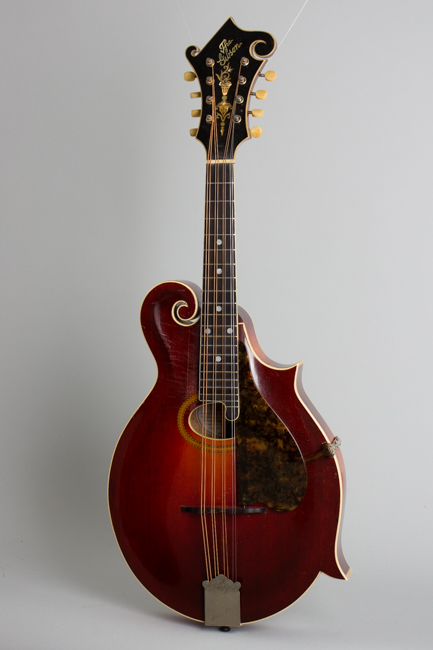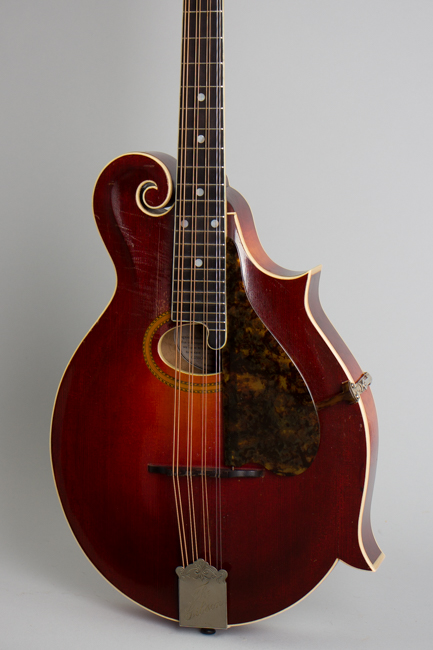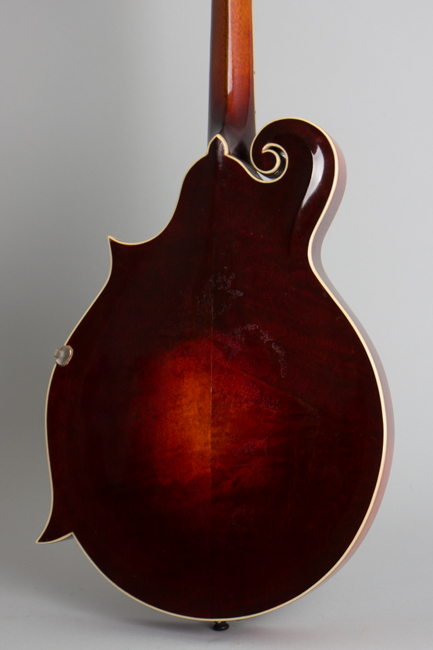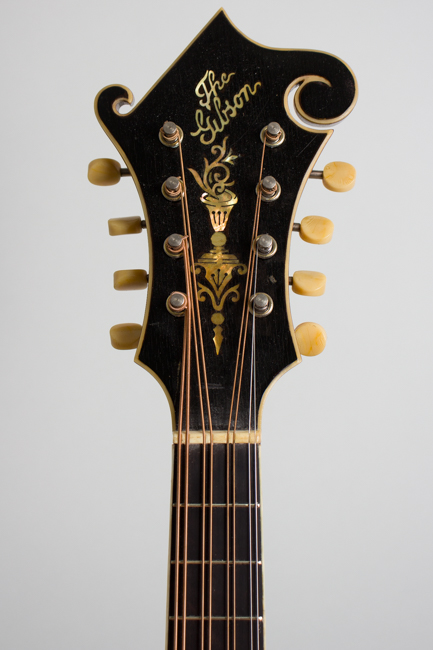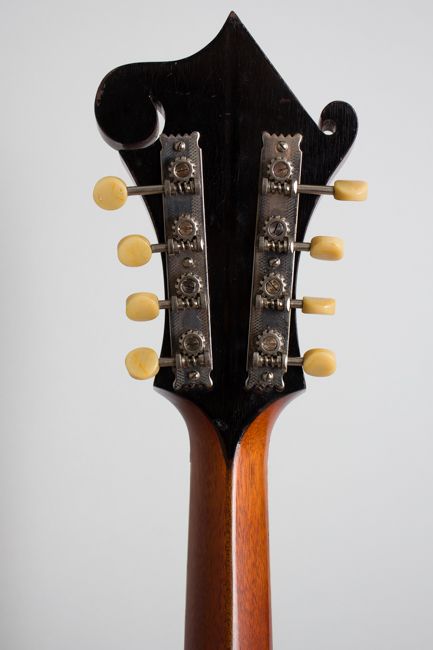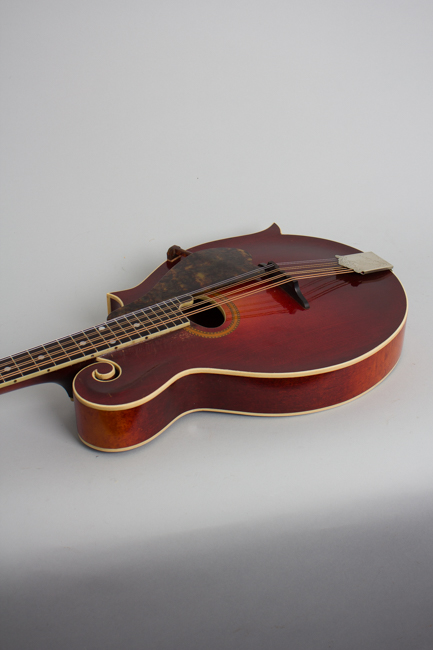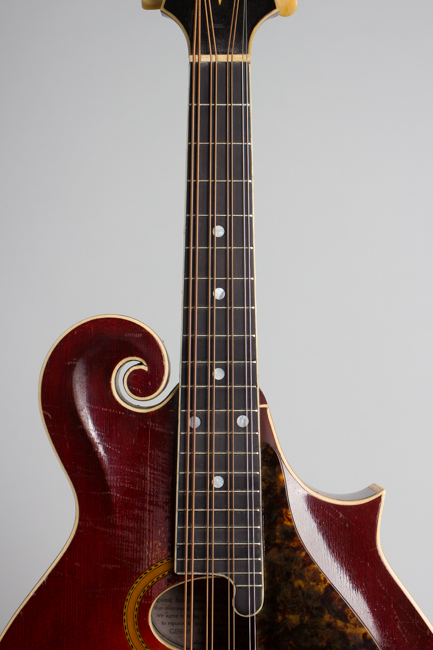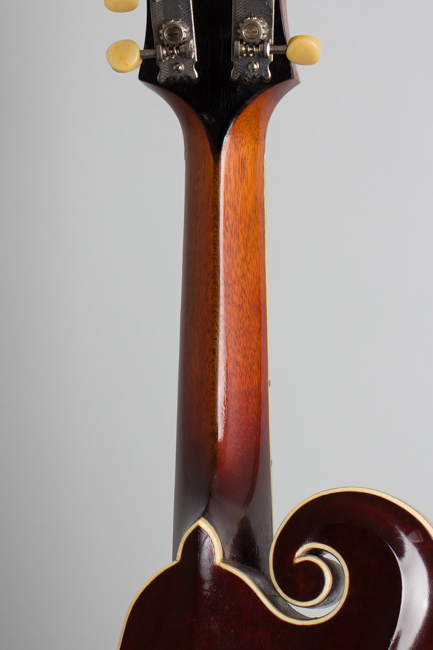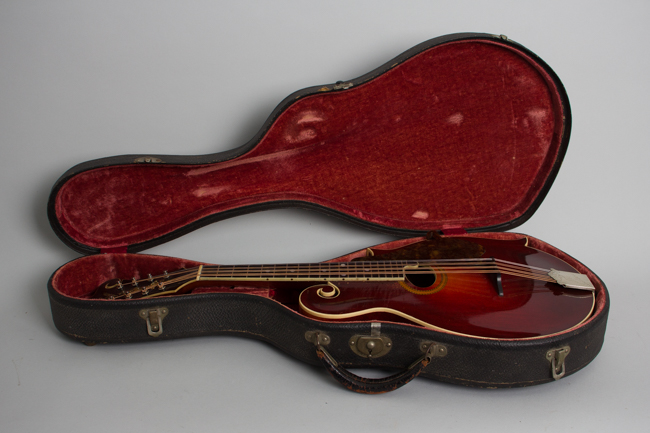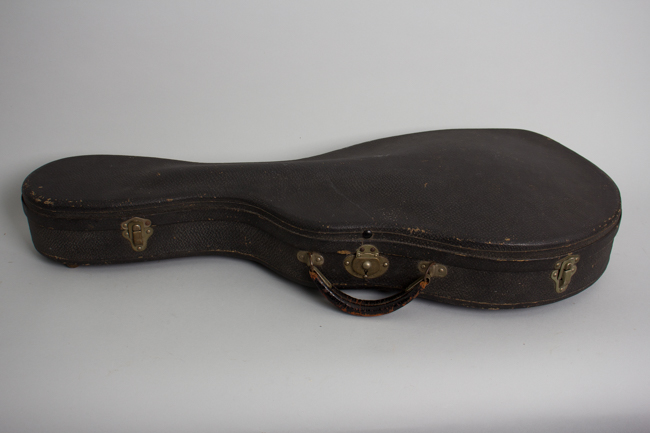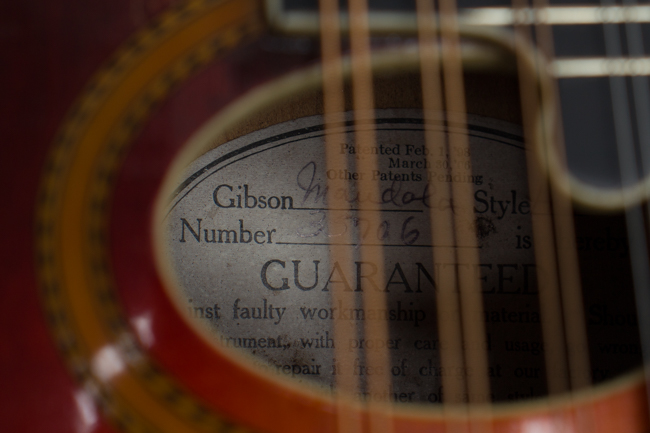Gibson H-4 Carved Top Mandola (1916)
This item has been sold.
Item # 11472
Prices subject to change without notice.
Gibson H-4 Model Carved Top Mandola (1916), made in Kalamazoo, Michigan, serial # 35706, red sunburst varnish finish, maple back and rim, spruce top; laminated mahogany neck with ebony fingerboard, original black hard shell case.
This is a lovely sounding 1916 Gibson H-4 Mandola, the middle instrument in the mando-trio that the early 20th Century Gibson company avidly promoted. This is Gibson's scroll-body equivalent to the viola, designed to fill the same orchestral role. While built in the largest relative quantity in the 1910's mandolas from any period are far from common, even at the time rarely seen outside the confines of the mandolin orchestra.
The H-4 was the fanciest, most expensive Mandola Gibson offered in the 1910s priced at $125 (plus case). This was a substantial sum for a fairly limited-use instrument, even when Gibson teacher/agents promoted sales by offering time payment options. The H-4 was produced only in relatively small numbers and is one of the rarest of the mandolin orchestra pieces the Kalamazoo company sold at the time.
A direct companion to the F-4 mandolin, the H-4's larger scroll body and deep red sunburst finish make it a visually striking instrument, with Gibson's signature flowerpot inlay on the art nouveau-styled headstock. It features a two-piece back and sides of subtly flamed maple; despite Gibson's catalog descriptions, at this time only Style 4 instruments were actually built with the specified maple body. The top, back, sides and neck feature a beautiful dark, rich red sunburst finish and are single bound in grained ivoroid. The headstock carries a slanted pearl script Gibson logo and Handel strip tuners with grained ivoroid buttons. The pickguard is the usual elevated tortoise celluloid piece, with the 1910's metal bracket clamp.
This mandola is well past its 100th birthday and remains a exquisitely styled, easy playing and excellent sounding instrument with a smooth and powerful tone suitable for a variety of musical styles, some of which are still waiting to be discovered!
Overall length is 28 3/4 in. (73 cm.), 11 in. (27.9 cm.) wide at lower bout, and 2 1/16 in. (5.2 cm.) in depth, measured at side of rim. Scale length is 15 3/4 in. (400 mm.). Width of nut is 1 1/4 in. (32 mm.).
This mandola shows some general play wear but is in excellent structural shape even after 105+ years. The original finish is still bright and bold with some typical micro-checking. It shows typical wear, with noticeable pick marks above the fingerboard between the front edge and soundhole being the most obvious. The rest of the finish has mostly minor dings and dents; the center of the back has some finish loss from what may have been something affixed there long ago, possibly a large floral decal. The finish on the back of the neck is partially worn down to the primer and just to the wood in places, evidence of some dedicated play time probably long ago.
A spruce grain crack has been glued up coming off the front edge of the body 1/2" above the fingerboard; there was no touch up added to the finish. There is a very small grain split to the area just above the lower point, fully sealed and solid with a tiny touch up. The top of original one-piece bridge has been lowered a bit but retains the original character. The frets have been leveled and crowned and playability is excellent; the bone nut is old but may not be original.
This is not a pristine instrument but remains simply a beautiful mandola with a wonderful sound, deep and rich but still with plenty of bark and presence. It still resides in the original HSC, with some ancient (and unfortunately crumbling) period Gibson Celluloid string packets in the pocket. This is really a lovely reminder of Gibson's original mission to perfect the mandolin orchestra in America, still a fabulous player's piece for any Mandola application, old or new! Overall Excellent - Condition.
This is a lovely sounding 1916 Gibson H-4 Mandola, the middle instrument in the mando-trio that the early 20th Century Gibson company avidly promoted. This is Gibson's scroll-body equivalent to the viola, designed to fill the same orchestral role. While built in the largest relative quantity in the 1910's mandolas from any period are far from common, even at the time rarely seen outside the confines of the mandolin orchestra.
The H-4 was the fanciest, most expensive Mandola Gibson offered in the 1910s priced at $125 (plus case). This was a substantial sum for a fairly limited-use instrument, even when Gibson teacher/agents promoted sales by offering time payment options. The H-4 was produced only in relatively small numbers and is one of the rarest of the mandolin orchestra pieces the Kalamazoo company sold at the time.
A direct companion to the F-4 mandolin, the H-4's larger scroll body and deep red sunburst finish make it a visually striking instrument, with Gibson's signature flowerpot inlay on the art nouveau-styled headstock. It features a two-piece back and sides of subtly flamed maple; despite Gibson's catalog descriptions, at this time only Style 4 instruments were actually built with the specified maple body. The top, back, sides and neck feature a beautiful dark, rich red sunburst finish and are single bound in grained ivoroid. The headstock carries a slanted pearl script Gibson logo and Handel strip tuners with grained ivoroid buttons. The pickguard is the usual elevated tortoise celluloid piece, with the 1910's metal bracket clamp.
This mandola is well past its 100th birthday and remains a exquisitely styled, easy playing and excellent sounding instrument with a smooth and powerful tone suitable for a variety of musical styles, some of which are still waiting to be discovered!
Overall length is 28 3/4 in. (73 cm.), 11 in. (27.9 cm.) wide at lower bout, and 2 1/16 in. (5.2 cm.) in depth, measured at side of rim. Scale length is 15 3/4 in. (400 mm.). Width of nut is 1 1/4 in. (32 mm.).
This mandola shows some general play wear but is in excellent structural shape even after 105+ years. The original finish is still bright and bold with some typical micro-checking. It shows typical wear, with noticeable pick marks above the fingerboard between the front edge and soundhole being the most obvious. The rest of the finish has mostly minor dings and dents; the center of the back has some finish loss from what may have been something affixed there long ago, possibly a large floral decal. The finish on the back of the neck is partially worn down to the primer and just to the wood in places, evidence of some dedicated play time probably long ago.
A spruce grain crack has been glued up coming off the front edge of the body 1/2" above the fingerboard; there was no touch up added to the finish. There is a very small grain split to the area just above the lower point, fully sealed and solid with a tiny touch up. The top of original one-piece bridge has been lowered a bit but retains the original character. The frets have been leveled and crowned and playability is excellent; the bone nut is old but may not be original.
This is not a pristine instrument but remains simply a beautiful mandola with a wonderful sound, deep and rich but still with plenty of bark and presence. It still resides in the original HSC, with some ancient (and unfortunately crumbling) period Gibson Celluloid string packets in the pocket. This is really a lovely reminder of Gibson's original mission to perfect the mandolin orchestra in America, still a fabulous player's piece for any Mandola application, old or new! Overall Excellent - Condition.
